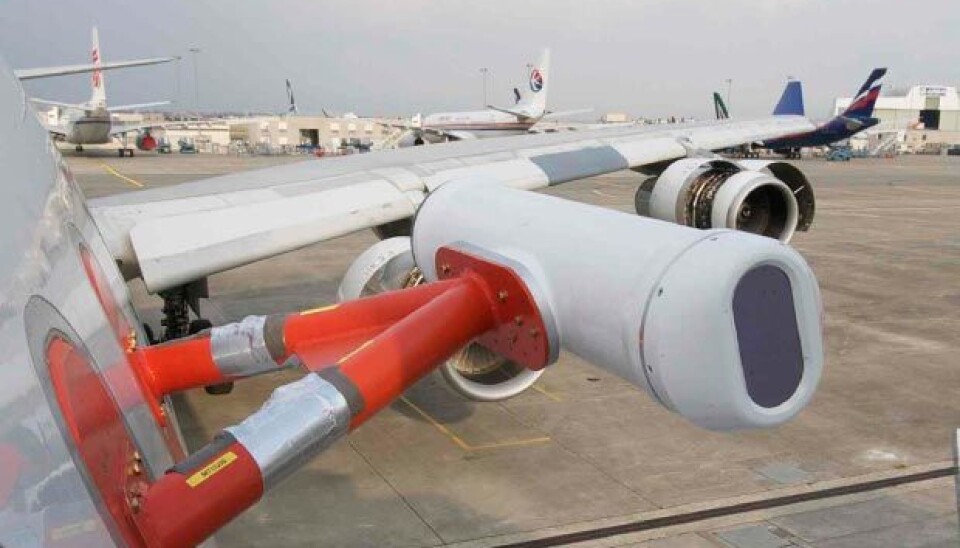This article was produced and financed by NILU - Norwegian Institute for Air Research

Volcanic ash detection technology tested on aircraft
An infrared system that detects and informs about volcanic ash in the atmosphere has been tested on an Airbus A340.
Denne artikkelen er over ti år gammel og kan inneholde utdatert informasjon.
"We are happy to confirm that the system also works in high altitudes where the big commercial aircraft fly," says Dr. Fred Prata from Norwegian Institute for Air Research (NILU), inventor of the system.
Nicarnica Aviation and easyJet have entered a partnership with Airbus to test the AVOID (Airborne Volcanic Object Identifier and Detector) ash detection system at the speed and altitude of commercial aircraft. Nicarnica Aviation is a spin-off company of NILU.
“It is important to test the equipment at the altitudes where commercial aircraft fly. These can be as high as 38,000 feet, where it is very cold (<-55 C)," says Prata.
He explains that the trials over Toulouse showed that AVOID works well at high altitude and normal cruise speeds. The system imaged clouds 100 km ahead of the A340, demonstrating for the first time that passive infrared cameras can provide sufficient warning time.
Large aircraft companies meet small research environment

After this first successful round of testing, Airbus and easyJet, together with Fred Prata and Adam Durant from NILU and David Moriano from Nicarnica Aviation, will cooperate to further develop the system.
"We are very pleased to have both easyJet and Airbus on our team. It is of vital importance to perform necessary tests of the system and it will also provide good opportunities for the commercialization," states John Ackermann, Business director at Nicarnica Aviation.
Using the Saharan Air Layer as a proxy for volcanic ash, the test aircraft will now fly over the Atlantic Ocean west of Morocco to prove the equipment can detect the fine particles of sand at altitudes of up to 20,000 feet and a distance of around 100km.
"If the conditions look right, we will fly down to the Canary Islands and search for Saharan dust layers," says Adam Durant.

He adds that the spectral characteristics of desert dust are similar to volcanic ash. This allows the researchers to use desert dust as an analogue for volcanic ash to test their system when they don’t have a volcanic ash cloud to work with.
The final phase of testing will be to fly the Airbus A340 aircraft during a major volcanic eruption later this year - volcanic activity is likely to take place in areas such as Indonesia, Alaska, Japan and, of course, Iceland.
AVOID was successfully tested in the skies over Mount Etna and Stromboli in November and December 2011 on a Flight Design CT aircraft at altitudes of up to 12,000ft.
How AVOID works
The AVOID system may be likened to a weather radar for ash. Created by Dr Fred Prata, the system comprises of infrared technology (developed by the US military) fitted to aircraft to supply images to pilots and an airline’s operations control centre.

The images will enable pilots to see an ash cloud, up to 100 km ahead of the aircraft and at altitudes between 5,000ft and 50,000ft, thus allowing them to make adjustments to the plane’s flight path to avoid any ash cloud.
On the ground, information from aircraft with AVOID technology would be used to build an accurate image of the volcanic ash cloud using real time data. This would open up large areas of airspace that would otherwise be closed during a volcanic eruption, which would benefit passengers by minimising disruption.
AVOID in action
At the end of testing the AVOID system will be ready to go into mass production. easyJet estimates that 100 aircraft (20 of which would be easyJet’s) across Europe fitted with AVOID equipment, would provide comprehensive coverage of the continent enabling airlines to supply monitoring information to the authorities to support the new processes and procedures that were introduced after the eruption of Eyjafjallajökull in 2010.
This information would enable all airlines to continue to fly safely in line with the CAA guidance of safe flying zones.






























